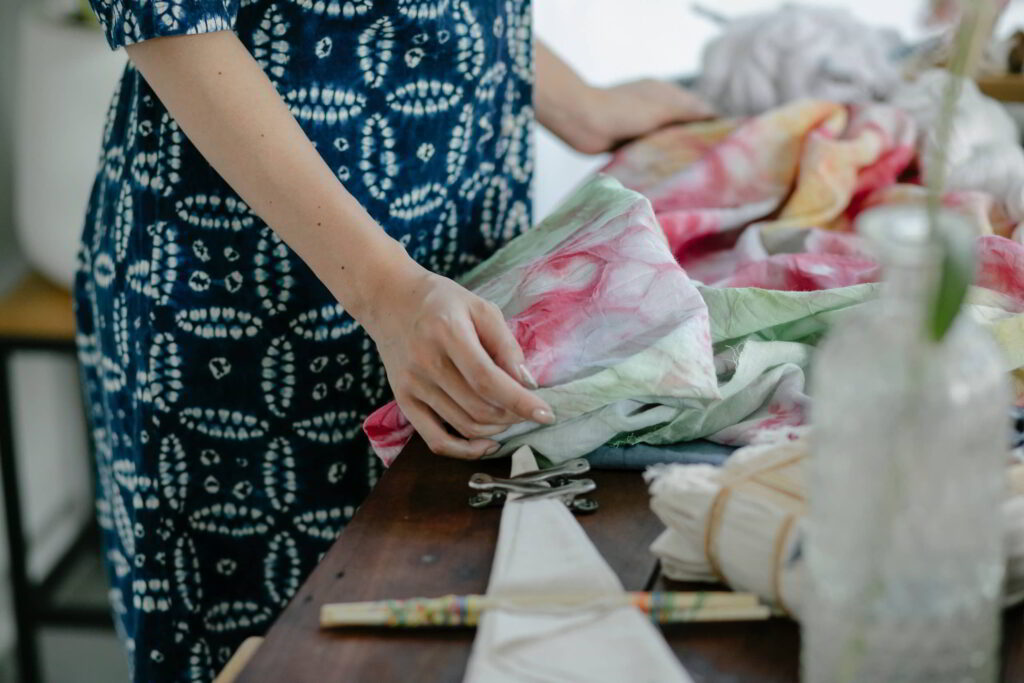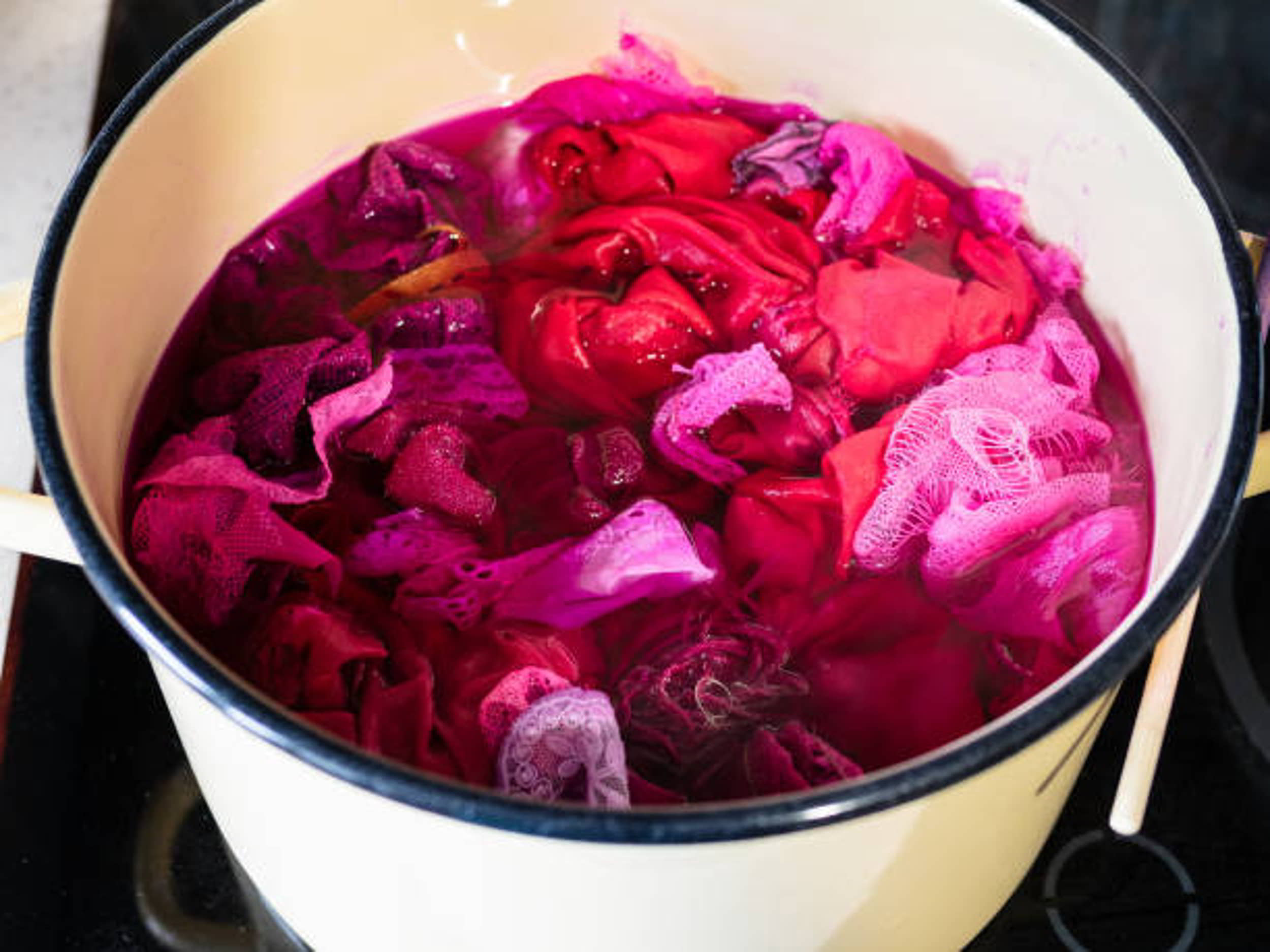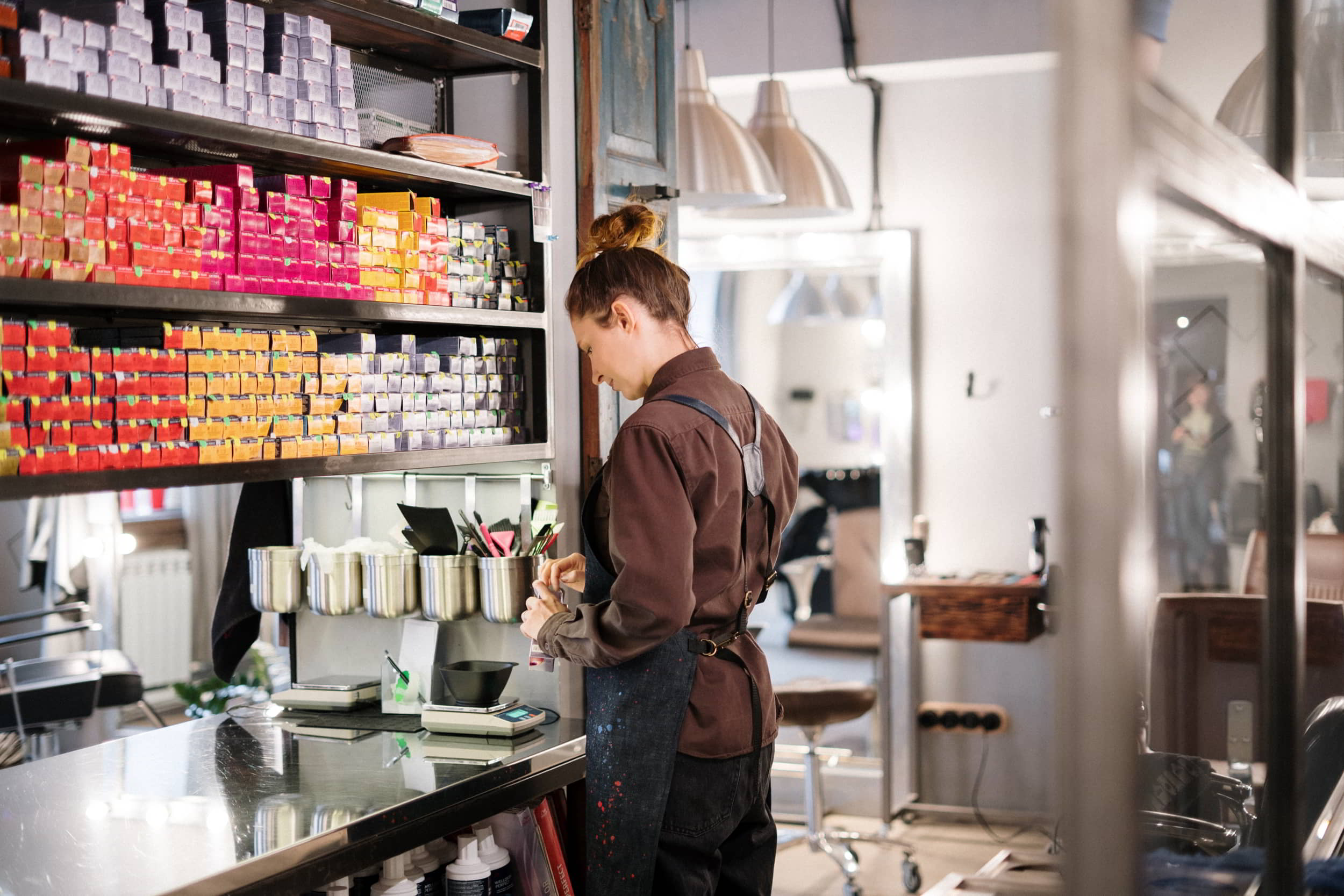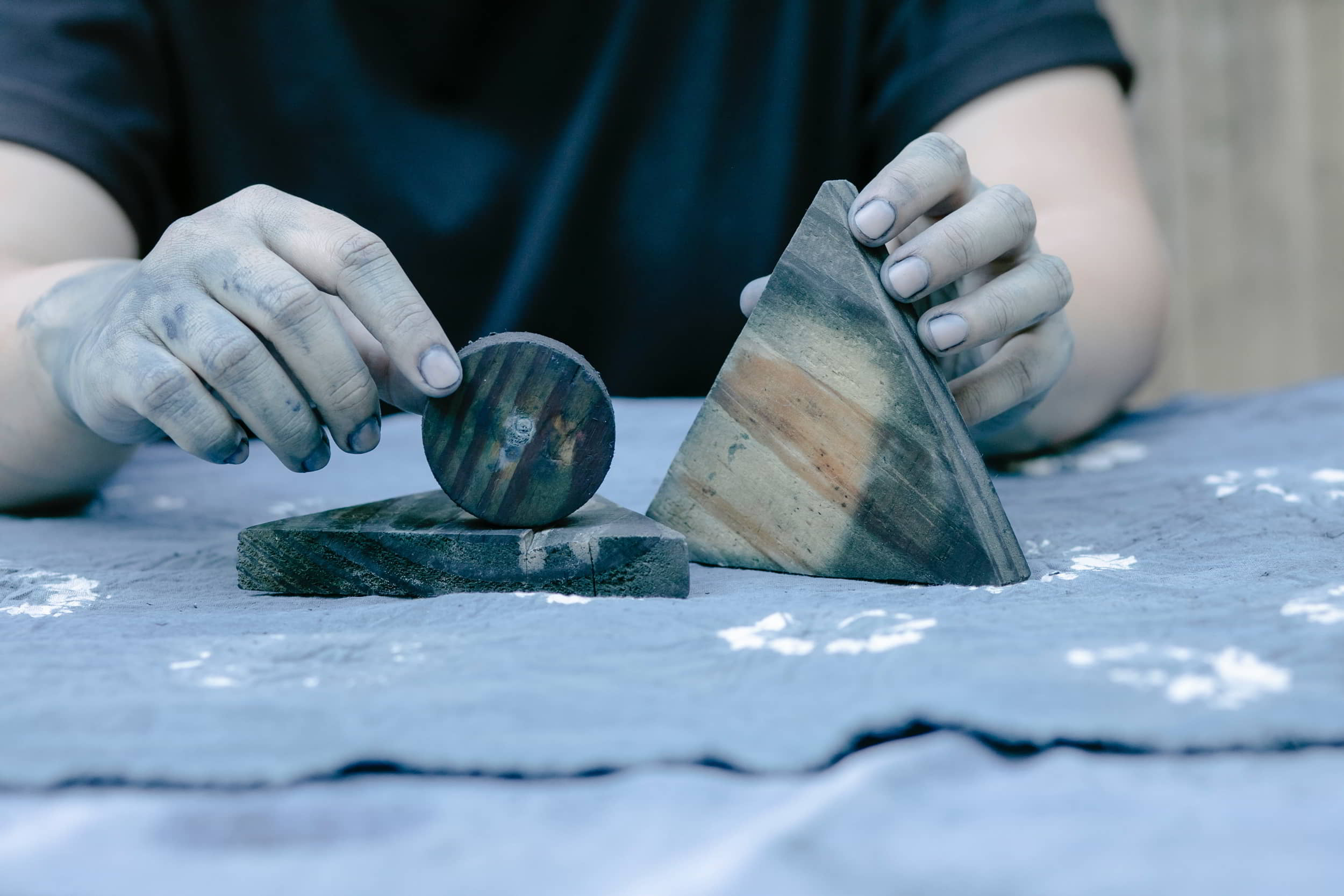Fabric dye is a coloring agent used to change or enhance the color of textiles, such as clothing, upholstery, or craft materials. It allows you to personalize or refresh the appearance of fabrics by adding color. Fabric dyes can be found in various forms, including liquid, powder, and pre-soaked dyeing kits. There are different types of fabric dyes, and the choice of dye depends on the type of fabric you’re working with and the desired outcome.
What fabric works best for tie dye
The choice of fabric is crucial in achieving vibrant and long-lasting tie-dye results. Fabrics that work best for tie-dyeing have a few key characteristics:
1. Natural Fibers: Fabrics made from natural fibers like cotton, hemp, linen, and rayon tend to absorb dye more effectively and produce brighter colors. Cotton, in particular, is one of the most popular choices for tie-dye projects due to its excellent dye absorption and comfortable feel.
2. Light Colors: Light-colored fabrics provide a blank canvas for tie-dye patterns and allow the colors to stand out vividly. White or pale pastel colors are ideal because they showcase the dye’s vibrancy.
3. Tight Weave: Fabrics with a tight weave, like those found in high-quality cotton T-shirts or pillowcases, hold the dye better and result in sharper, more defined patterns.
4. Pre-Washed and Pre-Shrunk: It’s a good practice to pre-wash and pre-shrink your fabric before tie-dyeing to remove any sizing or contaminants that might interfere with the dye’s absorption.
5. No Wrinkle-Resistant or Stain-Resistant Finishes: Avoid fabrics with wrinkle-resistant or stain-resistant finishes, as these coatings can hinder the dye’s penetration.
While natural fibers are the most common choice for tie-dye projects, you can experiment with synthetic blends. However, remember that synthetic fabrics like polyester may not absorb dyes as effectively, resulting in softer or pastel colors rather than the bold, vibrant hues typically associated with tie-dye. Additionally, the dyeing process for synthetics may require different techniques and dyes specifically formulated for synthetic fabrics. Ultimately, the best fabric for tie-dye depends on the look and feel you want to achieve in your project, so consider your preferences and the intended use of the dyed item when selecting your fabric.
Check our website Here:
How to set dye in fabric

Setting dye in the fabric is a crucial step in the fabric dyeing process that helps ensure the color remains vibrant and doesn’t bleed or fade prematurely. Here’s how to set dye in fabric:
1. Rinse and Remove Excess Dye: After the dyeing process is complete, thoroughly rinse the dyed fabric under cold running water until the water runs clear. This helps remove any excess dye that hasn’t bonded with the fabric.
2. Use a Fixative (if necessary): Some dyes, especially natural or vegetable dyes, may require a fixative to set the color. Common fixatives include vinegar for plant-based dyes and citric acid for some synthetic dyes. Follow the dye manufacturer’s instructions for the appropriate fixative and concentration.
3. Heat-Setting: Heat-setting is critical in setting dye in the fabric. It’s usually done by applying heat to the dyed fabric, which helps the dye molecules bond with the fibers. The specific heat-setting method can vary depending on the type of dye:
· Steam Setting: You can steam-set the best dye for fabric like silk or wool fabrics. Hang the fabric in a steamer or steam it with an iron hovering above it (without direct contact) for a set amount of time, typically 20-30 minutes.
· Iron-Setting: Using a hot iron to set the dye for cotton and other natural fibers. Place a clean cloth or paper towel over the dyed fabric and iron it at the appropriate temperature for the dye type. This process may require several minutes of continuous ironing.
· Baking: Some dyes, particularly those in certain fabric spray dye kits, require baking the fabric in an oven at a specific temperature for a designated time. Follow the instructions on the dye package for baking settings.
4. Cool and Rinse Again: Allow the fabric to cool to room temperature after heat setting. Then, rinse it in cold water to remove any residual fixative or loose dye.
5. Wash Carefully: Wash the fabric separately in cold water with a mild detergent to remove any remaining loose dye particles. Avoid using harsh detergents or bleach, as they can affect the color.
6. Dry Appropriately: Depending on the fabric type, follow the care instructions for drying. Some fabrics can be air-dried, while others may be machine-dried on low heat. Avoid exposing the dyed fabric to direct sunlight for extended periods, which can cause colors to fade.
7. Perform a Colorfast Test: Before incorporating the dyed fabric into your project or wearing it, perform a colorfastness test by rubbing a damp white cloth against the dyed fabric. If color transfers to the material, continue rinsing and washing until it no longer does.
Setting dye in fabric ensures that your dyed items remain vibrant and colorfast, even after repeated washes. Following these steps and any specific dye manufacturer instructions will help you achieve the best and longest-lasting results.
Here’s a general overview of how to dye fabric:
How to use fabric dye
Materials you’ll need:
1. Fabric: Choose the fabric you want to dye. Make sure it’s clean and free of any stains or residues.
2. Fabric Dye: Select the appropriate fabric to dye based on your fabric type and the color you want to achieve. Common types of best fabric dyes include:
· Direct Dyes: Suitable for cotton, linen, and rayon.
· Reactive Dyes: Ideal for natural fibers like cotton, wool, silk, and rayon.
· Acid Dyes: Used for protein fibers like silk, wool, and nylon.
· Synthetic Dyes: Designed for synthetic fabric dye like polyester and nylon.
3. Salt or Vinegar: Depending on the type of dye you’re using, you may need salt (for some direct dyes) or vinegar (for some acid dyes) to help set the color.
4. Plastic Containers: You’ll need containers to mix and hold the dye solution.
5. Plastic Spoons or Stirrers: For stirring the dye.
6. Rubber Gloves: To protect your hands from staining.
7. Measuring Cups: To measure the dye and other ingredients accurately.
8. Plastic Bags or Plastic Wrap: For wrapping the fabric during dyeing.
9. Water: You’ll need water for mixing the dye and rinsing the fabric.
How to dye fabric:
Steps to dye fabric paint:
1. Prepare the fabric: Wash and thoroughly rinse the fabric to remove any dirt, chemicals, or sizing. This will ensure the dye adheres evenly.
2. Mix the dye: Follow the instructions on the dye packaging to mix the dye with water. Use the recommended dye-to-water ratio, and add any necessary salt or vinegar.
3. Pre-soak: Wet the fabric with water, then immerse it in a water container for a few minutes. This helps the fabric absorb the dye more evenly.
4. Apply the dye: Submerge the fabric in the bath, ensuring it’s fully saturated. You can use techniques like immersion dyeing, tie dyeing, or dip-dyeing to achieve different patterns and effects.
5. Allow to set: Let the fabric sit in the dye bath for the recommended time, typically 20-60 minutes, depending on the dye type and the color intensity you desire.
6. Rinse: Rinse the dyed fabric under cold running water until the water runs clear. Gradually increase the water temperature to lukewarm, then cool again to prevent the color from bleeding.
7. Wash and dry: Wash the dyed fabric separately in cold water with a mild detergent. Dry it according to the fabric’s care instructions.
8. Optional: You can repeat the dyeing process to achieve more vibrant colors or deeper shades.
Remember that different natural dyes for fabric may require slight variations in the dyeing process, so always follow the instructions provided with your specific dye product for the best results. Additionally, practice safety precautions, such as wearing gloves and working in a well-ventilated area, when handling fabric dyes.
Can I soak fabric in the rit dye overnight?
You can soak fabric in Rit dye overnight to achieve more vibrant and long-lasting color results. Allowing the fabric to sit in the dye bath for an extended period, such as overnight, allows the dye to penetrate the fibers thoroughly, resulting in a richer and deeper color saturation. However, it’s essential to follow Rit Dye’s specific instructions and recommendations for the type of fabric you’re dyeing and the particular dye product you’re using. Different fabrics and Rit dye formulations may require varying soaking times, so always refer to the product’s guidelines to ensure the best outcome and colorfastness.
How to dye fabric black without dye
Dyeing black fabric dye without conventional fabric dye can be challenging, but it’s possible with certain alternative methods. One approach is to use black fabric paint or fabric markers. Start with a white or light-colored fabric, and then apply multiple layers of black fabric paint, allowing each layer to dry thoroughly before adding the next. This method will enable you to build up the black color gradually. Alternatively, you can use black dye spray for fabric designed for fabric applications. Again, layering and allowing proper drying time between coats is essential for achieving a deep black shade. Remember that these methods may not be as colorfast or long-lasting as traditional fabric dyes, and they may result in a different texture on the fabric surface. Always follow the product instructions and consider doing a colorfastness test to ensure the desired results.
How to use rit fabric dye
Using fabric dye rit is a straightforward and versatile way to add color to a wide range of textiles. To get started:
- Ensure your fabric is clean and damp.
- Prepare a dye bath by following the instructions on the Rit dye package, mixing the dye with hot water and any necessary salt or vinegar.
- Submerge your fabric in the dye bath, ensuring it’s fully saturated, and stir regularly for even coloring.
- Leave the fabric in the dye bath for 10-30 minutes, depending on your desired shade.
- After dyeing, rinse the fabric under cold running water until the water runs clear, gradually adjusting the temperature to prevent color bleeding.
- Wash the dyed fabric separately with a mild detergent, and once dry, you’ll have successfully transformed your textiles with Rit fabric dye, offering vibrant and personalized color results.




